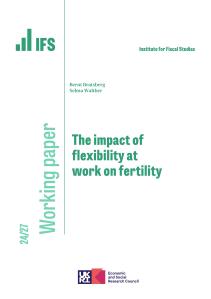This chapter is concerned with the differences between men and women in all activities that can be labelled as ‘work’ – that is, the time and energy that people devote to producing things of value. Work thus encompasses the production of market goods and service as well as the time spent doing household chores, childcare or care of the elderly.
Data from the UK and other high-income countries reveal a sharp, if unsurprising, divide: men do more paid work outside the house, women do more unpaid work inside. Moreover, when doing paid work, women are paid less. This pattern has remained stable in the past quarter of a century. Gender differences in the sharing of unpaid work – including the sharing of childcare, other care work, and housework – shape much of the unequal outcomes we see in the labour market; a deeply uneven division of unpaid work makes it hard to achieve equal outcomes in paid work.
Do these differences in labour market outcomes between men and women matter? In this chapter, we explore their many consequences and contend that there are several important reasons why they do: gender disparities in the amount of work individuals do, the types of work they do, and the rewards they get for doing that work are all central determinants of broader gender inequalities in social status, well-being and poverty. First off, work (both paid and unpaid) can be intrinsically important for well-being and life satisfaction. Second, different types of work bring different extrinsic rewards. Particularly important here is the distinction between paid and unpaid work. While unpaid work, such as housework and care work, is crucial for the functioning of the economy and society, the fact that it does not bring monetary rewards can leave people who do not work for pay vulnerable to economic hardship and poverty. This is the case both in the short and longer run, if the absence of paid work in the present reduces work opportunities and earnings in the future. Inequalities in paid work may also translate into broader inequalities in well-being if individual contributions to family income bring with them influence in important family decisions, reflecting how paid work can be directly connected to agency and autonomy.
At the level of the whole economy, gender inequalities may hamper aggregate efficiency and reduce the overall quantity of the goods and services (both market and non-market) produced. The amount of output that an economy can produce for a given level of resources is largest when the skills and talents of individuals are allocated to the activities where their return is largest. If women face higher barriers to participating in paid work (or, similarly, men face higher barriers to participating in domestic and care work), this will result in women’s (respectively men’s) talents not being put to their best use and will reduce overall efficiency. A corollary here is that such inefficiencies will reduce government tax revenue, which is an important point since it implies that even costly policies that succeed in putting women’s and men’s talents to better use in the labour market may ultimately pay for themselves.
Executive summary
- The average working-age woman in the UK earned 40% less than her male counterpart in 2019. That gap is about 13 percentage points, or 25%, lower than it was 25 years ago.
- The vast majority of the modest convergence in earnings of the past 25 years can be explained by the closing of the gender gap in education levels. Of the 13 percentage point drop in the gender pay gap, 10 percentage points (or over three-quarters) would have been expected from the rapid catch-up of educational attainment of women, who are now 5% more likely to have graduated from university than men. This suggests that the additional contribution to closing the gender earnings gap from other changes in policy, the economy and society over the past quarter-century has been muted.
- Inequalities in all three components of labour market earnings – employment, working hours and hourly wages – remained large. In 2019, working women still earned 19% less per hour than men. This gap was 5 percentage points smaller than the gap in the mid 1990s, though again women’s relative advances in education can account for the majority of the gain.
- Gaps in all three components are linked. The fact that women have more career breaks and years working part-time contributes to them having lower hourly earnings further down the line.
- In a big break from the past, the hourly wage gap between men and women is now bigger for those with degrees or A-level-equivalent qualifications than for those with lower education. It used to be that gender differences in hourly wages were especially large among less-well-educated workers. The introduction of, and increases to, the UK’s minimum wage have been an important factor in helping low-paid women. More highly educated women have not made comparable progress.
- Gender gaps in hourly wage rates are especially large at the top, with women failing to reach the same levels of high pay as men. In 2019, women at the top (90th percentile) earned per hour only 77% of what their male counterparts did, while that figure was about 90% for women at the bottom (10th percentile) compared with men at the same level.
- Gender differences in time spent doing paid work are not completely balanced out by the differences in time doing unpaid domestic work. In the UK, working-age women on average do 1.5 fewer hours of paid work and 1.8 more hours of unpaid work per day than men.
- Gender gaps in pay, paid work and unpaid work have substantial consequences for inequalities in material living standards. Women in single-adult families, especially single mothers, are especially vulnerable to poverty. Women in opposite-gender couple families have been found to consume less than their male partners.
- Inequalities in earnings and its three components increase vastly after parenthood. The opening of gaps around childbirth suggests that unpaid care work is central in shaping inequalities in the labour market.
- The gendered roles that mothers and fathers take on appear to be largely unrelated to their relative earnings potential. Even mothers who earn more than their male partners before childbirth are more likely than their partners to reduce hours of work in the years after childbirth.
- The existing policy environment (including parental leave, childcare, and the tax and benefit system) often sustains and incentivises a traditionally gendered division of labour, even when policies are ostensibly gender-neutral. For instance, welfare subsidies that are taxed away with family income will disincentivise the work of a second earner, who is usually the woman. At the same time, policies designed to incentivise a more equal division of labour often have quite muted effects.
- At the level of the whole economy and society, these heavily gendered patterns of paid and unpaid work strongly suggest that the talents of women and men are not being used in the most productive way possible. This means that, overall, the economy produces less (both market goods and services and unpaid care) than would be possible if the talents of women and men were allocated more efficiently.
- Norms, preferences and beliefs appear central to the choices of families. Two-fifths of both men and women in the UK agree that ‘a woman should stay at home when she has children under school age’. Internationally, there is huge variation in the proportion of the population who hold traditional gender attitudes. The extent of agreement with such statements is strongly positively correlated with gender gaps in labour market outcomes.
- However, these constructs are not immutable. An accumulation of policies consistently supporting a more equal sharing of responsibilities between parents (or large policy reforms challenging gender roles) may help build up a change in attitudes that leads to permanent change in norms. Given the huge economic costs associated with the status quo, even expensive policies could potentially pay for themselves if they successfully ensure that the talents of both women and men are put to their most productive uses, whether in the labour market or at home.














